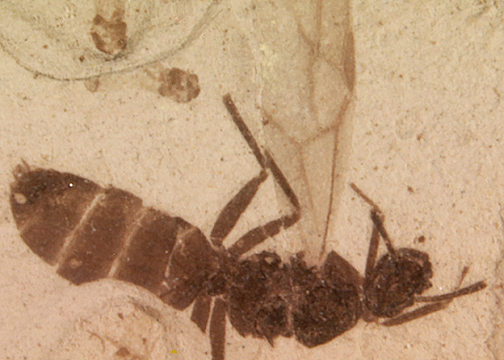Abstract
The early Oligocene (ca. 32.0 Ma) Canyon Ferry Reservoir deposit is known to contain an extraordinary number of well-preserved plant and animal fossils. Among those are 111 fossil ant specimens that were examined and assigned to five genera: Dolichoderus, Liometopum, Camponotus, Lasius, and Manica from three subfamilies: Dolichoderinae, Formicinae, and Myrmicinae. Two new fossil species are described. Liometopum greenwalti sp. nov. is the third fossil species known from this genus in North America and is morphologically distinct from the other two fossil species that are known from the Florissant deposit. The three fossil Liometopum species are compared to the three extant North American species. Manica iviei sp. nov. is the first fossil species in this genus known from North America and only the second fossil species described. This species possesses a broad ventral postpetiolar process which among North American extant species is only present in Manica hunteri. The Canyon Ferry ants represent the only definitively Oligocene-aged fossil deposit that contains ants in North America and therefore offer a unique view into a time when the modern-day ant communities of the continent were emerging.
References
- Antropov, A.V., Belokobylskij, S.A., Compton, S.G., Dlussky, G.M., Khalaim, A.I., Kolyada, V.A., Kozlov, M.A., Perlieva, K.S. & Rasnitsyn, A.P. (2014) The wasps, bees and ants (Insecta: Vespida = Hymenoptera) from the Insect Limestone (Late Eocene) of the Isle of Wight, UK. Earth and Environmental Science Transactions of the Royal Society of Edinburgh, 104, 335–446. https://doi.org/10.1017/S1755691014000103
- Arillo, A. & Ortuño, V.M. (2005) Catalogue of fossil insect species described from Dominican amber (Miocene). Stuttgarter Beiträge zur Naturkunde, Serie B (Geologie und Paläontologie), 352, 1–68.
- Barden, P. (2017) Fossil ants (Hymenoptera: Formicidae): ancient diversity and the rise of modern lineages. Myrmecological News, 24, 1–30.
- Bolton, B. (2023) An online catalog of the ants of the world. Available from https://antcat.org (accessed 27 July 2023).
- Bolton, B. (2003) Synopsis and classification of Formicidae. Memoirs of the American Entomological Institute, 71, 1–370.
- Boudinot, B.E., Borowiec, M.L. & Prebus, M.M. (2022) Phylo-geny, evolution, and classification of the ant genus Lasius, the tribe Lasiini and the subfamily Formicinae (Hymenoptera: Formicidae). Systematic Entomology, 47, 113–151. https://doi.org/10.1111/syen.12522
- Carpenter, F.M. (1930) The fossil ants of North America. Bulletin of the Museum of Comparative Zoology, 70, 1–66.
- CoBabe, E., Chamberlain, K., Ivie, M. & Giersch, J.J. (2002) A new insect and plant Lagerstätte from a Tertiary lake deposit along the Canyon Ferry Reservoir, southwestern Montana. Rocky Mountain Geology, 37 (1), 13–30. https://doi.org/10.2113/gsrocky.37.1.13
- Costa, E., Garcés, M., Sáez, A., Cabrera, L. & López-Blanco, M. (2011) The age of the “Grande Coupure” mammal turnover: New constraints from the Eocene-Oligocene record of the Eastern Ebro Basin (NE Spain). Palaeogeography, Palaeoclimatology, Palaeoecology, 301 (1–4), 97–107. https://doi.org/10.1016/j.palaeo.2011.01.005
- Creighton, W.S. (1950) The ants of North America. Harvard University, Cambridge, 585 pp.
- Dlussky, G.M. & Rasnitsyn, A.P. (2002) Ants (Hymenoptera: Formicidae) of Formation Green River and some other Middle Eocene deposits of North America. Russian Entomological Journal, 11, 411–436.
- Dlussky, G.M. & Putyatina, T.S. (2014) Early Miocene ants (Hymenoptera, Formicidae) from Radoboj, Croatia. Neues Jahrbuch für Geologie und Paläontologie, Abhandlungen, 272 (3), 237–285. https://doi.org/10.1127/0077-7749/2014/0409
- Fisher, B.L. & Cover, S.P. (2007) Ants of North America: A guide to the genera. University of California Press, Berkeley, Los Angeles, London, 216 pp. https://doi.org/10.1525/9780520934559
- Grimaldi, D. & Agosti, D. (2000) A formicine in New Jersey Cretaceous amber (Hymenoptera: Formicidae) and early evolution of the ants. Proceedings of the National Academy of Sciences of the United States of America, 97, 13678–13683.
- Heterick, B.E. & Shattuck, S. (2011) Revision of the ant genus Iridomyrmex (Hymenoptera: Formicidae). Zootaxa, 2845, 1–174.
- Jennings, E.O. (1920) Fossil plants from the beds of volcanic ash near Missoula, western Montana. Carnegie Museum Memoirs, 8, 385–427. https://doi.org/10.5962/bhl.title.45476
- LaPolla, J.S. & Barden, P. (2018) A new aneuretine ant from the Paleocene Paskapoo Formation of Canada. Acta Palaeontologica Polonica, 63 (3), 435–440. https://doi.org/10.4202/app.00478.2018
- LaPolla, J.S. & Greenwalt, D.E. (2015) Fossil ants (Hymenoptera: Formicidae) of the Middle Eocene Kishenehn Formation. Sociobiology, 62 (2), 163–174. https://doi.org/10.13102/sociobiology.v62i2.163-174
- LaPolla, J.S., Dlussky, G.M. & Perrichot, V. (2013) Ants and the fossil record. Annual Review of Entomology, 58, 609–630. https://doi.org/10.1146/annurev-ento-120710-100600
- Meyer, H.W. (2003) The fossils of Florissant. Smithsonian Books, Washington, D.C. & London, 258 pp.
- Perfilieva, K.S., Dubovikoff, D.A. & Dlussky, G.M. (2017) Miocene Ants (Hymenoptera, Formicidae) from Crimea. Paleontological Journal, 51 (4), 391–401. https://doi.org/10.1134/S0031030117040098
- Radchenko, A. & Khomych, M. (2022) Morphology and putative ecology of Eocene ant Agroecomyrmex duisburgi (Hymenoptera: Formicidae: Agroecomyrmecinae). Annales Zoologici, 72 (2), 261–268. https://doi.org/10.3161/00034541ANZ2022.72.2.009
- Scudder, S.H. (1877) The first discovered traces of fossil insects in the American Tertiaries. Bulletin of the U.S. Geological and Geographical Survey of the Territories, 3, 741–762.
- Toumoulin, A., Tardif, D., Donnadieu.Y., Licht, A., Ladant. J.-B., Kunzmann, L. & Dupont-Nivet, G. (2022) Evolution of continental temperature seasonality from the Eocene greenhouse to the Oligocene icehouse—a model-data comparison. Climate of the Past, 18, 341–362. https://doi.org/10.5194/cp-18-341-2022
- Wang, B., Shi, G.L., Xu, C.P., Spicer, R.A., Perrichot, V., Schmidt, A.R., Feldberg, K., Heinrichs, J., Chény, C., Pang, H., Liu, X.Y., Gao, T.P., Wang, Z.X., Ślipiński, A., Solórzano-Kraemer, M.M., Heads, S.W., Thomas, M.J., Sadowski, E.M., Szwedo, J., Azar, D., Nel, A., Liu, Y., Chen, J., Zhang, Q., Zhang, Q.Q., Luo, C.H., Yu, T.T., Zheng, D.R., Zhang, H.C. & Engel, M.S. (2021) The mid-Miocene Zhangpu biota reveals an outstandingly rich rainforest biome in East Asia. Science Advances, 7 (18), eabg0625. https://doi.org/10.1126/sciadv.abg0625
- Wheeler, W.M. (1917) The mountain ants of western North America. Proceedings of the American Academy of Arts and Sciences, 52 (8), 457–569. https://doi.org/10.2307/20025695
- Zharkov, D., Dubovikoff, D. & Abakumov, E. (2023) The first fossil record of the genus Manica Jurine, 1807 from Late Eocene Baltic amber and discussion of the early evolution of Myrmicini (Hymenoptera: Formicidae: Myrmicinae). Insects, 14 (1), 21. https://doi.org/10.3390/insects14010021


